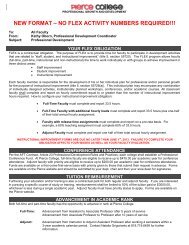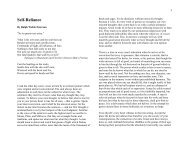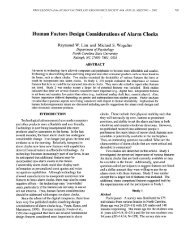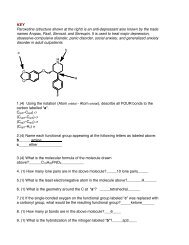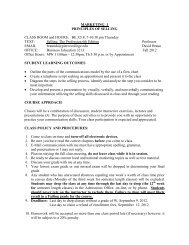Chapter 11 Principals Of Marketing - Faculty.piercecollege.edu
Chapter 11 Principals Of Marketing - Faculty.piercecollege.edu
Chapter 11 Principals Of Marketing - Faculty.piercecollege.edu
You also want an ePaper? Increase the reach of your titles
YUMPU automatically turns print PDFs into web optimized ePapers that Google loves.
CH <strong>11</strong>] Business 101 — The Basics <strong>11</strong>-5<br />
How a cracked out egg spreads on the plate via grade.<br />
When the manufacturer receives funds from the wholesaler then the manufacturer<br />
can produce additional goods. When retailers extend credit to their customers, they<br />
may increase total sales through credit arrangements.<br />
Risk taking is dealing with the uncertainties of future market forces and<br />
consumer behavior. Farmers grow soybeans without the guarantee that their will be<br />
a market for their crop and with the hope that their crop will be able to be harvested<br />
without damage or loss. Wholesalers and retailers acquire inventory for resale on<br />
the basis of their research of what retail consumers will buy. This action removes<br />
the manufacturer's risk and gives it to marketing intermediaries. There is no<br />
guarantee for the automotive industry that their new car model will sell in quantity<br />
or as rapidly as they manufacture. Manufacturers accept risk when they sch<strong>edu</strong>le<br />
production of a product speculatively before consumers have entered orders.<br />
Standardization and grading deals with standardizing the products in terms of<br />
use, size, and form. Many industries standardize their products with modifications<br />
to differentiate their product from the competition. There are many different tire<br />
manufacturers from which one may select the same size, shape and functionality of<br />
tire for an automobile. Grading standards deals with the quality of the product. Eggs<br />
are sold in grocery stores by standardized size (weight) and grade. These standards,<br />
grades, and weight classes have been developed and are promulgated pursuant to<br />
the authorities contained in the Agricultural <strong>Marketing</strong> Act of 1946, as amended, (7<br />
U.S.C. 1621 et seq.) and are now maintained by the Agricultural <strong>Marketing</strong> Service,<br />
U.S. Department of Agriculture. To illustrate: the standard size of eggs are X-Large,<br />
Large, Medium, Small and Pee-Wee, though one generally does not purchase the<br />
small and Pee-Wee in grocery stores. Egg grades that may be sold in retail outlets<br />
include AA, A, and B. The size of an egg is established by its weight and the grade<br />
of the egg is established by its shell characteristics, clarity in candling, and freedom<br />
from defects and diseases.<br />
Marketers collect and analyze market information to determine what will sell<br />
and who will buy it. Marketers are concerned with the buyer behavior and consumer<br />
patterns. Organizations that focus on discovering consumer needs and then<br />
GRADE: AA<br />
GRADE: A<br />
GRADE: B



